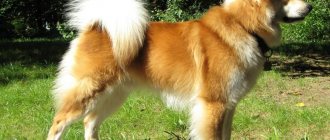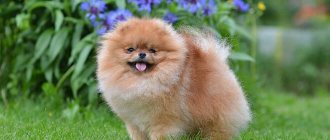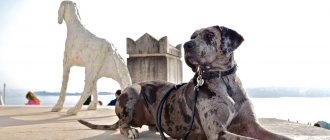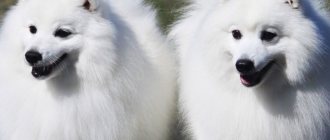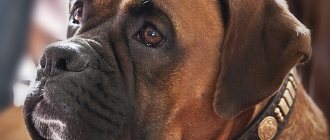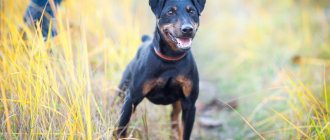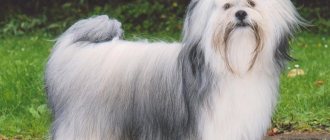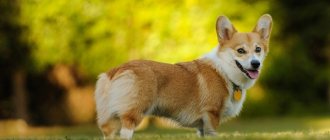Video
* We invite you to watch a video about the German Spitz . In fact, in front of you is a playlist in which you can select and watch any of 20 videos about a given dog breed by simply clicking on the button in the upper right corner of the window. In addition, the material contains quite a lot of photos. By looking at them you can find out what a German Spitz looks like.
In this article:
|
Rate the material!
[Total votes: 1 Average: 5]
The German Spitz is a robust dog, recognizable by its abundant fur, collar and tail, fox-like head and pointed ears. All this gives her an elegant and playful look. The German Spitz is available in 5 different sizes, ranging from the largest to the smallest. Apart from size, physical characteristics are almost the same for all species.
Character
Do you want to have a very active and highly intelligent friend who does not require any special care and who does not need a lot of space in the apartment? Then choose a Middle Spitz.
They are amazing. Just one cold leather nose poking into every place in the apartment is worth it! Spitz curiosity knows no bounds. Therefore, you will have to carefully ensure that there are no objects nearby that could harm the small dog.
What to do with a Spitz dog? Buy a few hard balls and leave them for your pet when you leave home. Let him have fun. But, given the active nature of the dog, it is not a fact that he will not get bored with toys.
The best entertainment for representatives of the breed is communication with the owner. These dogs are extremely loyal and sociable. Where the owner goes, the Spitz goes. The owner sat down on the sofa, and the pet was already right there, wagging his tail and looking into his eyes devotedly. If your beloved owner allows you to climb onto the sofa and sit next to him, the Pomeranian’s endurance will be enough for a few minutes. He will immediately begin to climb on his knees and talk with all his appearance about how he wants to play.
These dogs get along very well with older children. A very young child can cause pain to a pet. And the Spitz is a proud creature. He will snap at the offender. This breed is not recommended for families with very young children. But for a schoolchild such a friend would be ideal. You can walk, play and play pranks together.
Spitz dogs love long and active walks. And this despite their size. The dog is able to fetch the ball tirelessly, demanding play again and again. Don't mind running. And if the owner is active, then the dog will be happy to keep him company.
Restrained with strangers. It will bark loudly, notifying you that a stranger is approaching the door. He gets to know the guests carefully and only after that decides whether to allow himself to be petted or not. An overly annoying guest who wants to pet a small dog will be immediately put in his place. This cunning fox face has sharp teeth.
Loves to be carried in the arms of its owner. The average German Spitz should not be accustomed to such walks. These dogs are smart, they quickly “probe” the owner, find his weakness and sit on his neck.
History of the origin of the German Spitz
The history of the German Spitz dates back to prehistoric times, as its characteristics correspond to the Stone Age "peat bog" and lake dog. Professor Theodor Studer of the University of Bern claims that dog bones found in archaeological excavations of Swiss lakes (circa 4500 BC) are similar to the bones of our modern Spitz dogs. Therefore, we can say that all German Spitz dogs have a Spitz ancestor.
The ancestor of our current Spitz was often represented in art (Greek, Egyptian, Roman), including mosaics of Pompeii. Since the 18th century it has been found in several European paintings. In 1793, Georges Stubbs captured the Prince of Wales's dog on canvas. Thomas Gainsborough featured the Pomeranian in several of his paintings, as did Burton Barber, who painted Queen Victoria's Pomeranian.
Interesting fact: In 1750, Count Buffon officially classified the Spitz as a wolf dog in his classification of dog breeds. This classification was adopted by the Danish naturalist Linne. In the 19th century, the “wolf dog” became very popular.
In 19th century France he was given the name Lulu, which in 1895 became Lulu of Alsace and later Lulu of Pomerania, giving a Germanic identity to the future Spitz. Very quickly this dog becomes popular. Due to poorly controlled hybridization, the breed is somewhat degenerating. Lulu becomes a noisy dog, aggressive, ill-built, and without fur. He becomes a pug with a nasty reputation and is then called a "concierge dog."
Fortunately, official cynophilia is aware of this phenomenon and is pushing breeders to respond. This would be done by importing English dogs, the selection of which continued without loss of control over the species. It wasn't until 1961 that he officially took on his modern name, Spitz.
In 1891, 14 Spitz dogs were registered at the Kraft Dog Show. In 1880, Queen Victoria promoted the breed by entering and winning several dog shows. Many famous people had a Pomeranian: Martin Luther, Michelangelo, Mozart, Georges III, Marie Antoinette, Empress Josephine, Empress Eugenie, Emile Zola, Courtelin and even closer to us Claudia Schiffer.
Spitz: where did it all begin?
Like any other dog breed, the Spitz has its own history, dating back to the Neolithic era. It mixes legends, true stories and facts, which we will get to know further.
The oldest roots of the Spitz
In the 19th century, archaeologists studying finds from the Neolithic era found the remains of an animal, clearly domesticated, on the site of pile dwellings. The animal resembled a wolf, but only partly. An attempt to recreate the appearance led to unexpected conclusions - the found skeleton clearly belonged to a dog, similar in structure to modern Spitz.
The roots of the Spitz, going back to the Neolithic, remained a mystery until the nineteenth century
The pile dog, or peat dog, as it is also called, due to the fact that excavations were carried out in the peat bogs of Switzerland, is considered the ancestor of most modern breeds.
Interesting facts about the origin of the breed
Fans of Spitz decorative dogs tend to be of the opinion that these dogs lived under the pharaohs. Many items from that time contain images of small, pointed-nosed dogs, very similar to modern representatives of this breed.
One of the beautiful legends tells about three Spitz dogs who accompanied the wise men who carried gifts to the baby Jesus.
For a long time, Spitz dogs were not perceived at all as purebred dogs.
Larger relatives of the Spitz, dogs weighing up to 30 kg, could be found both in rich houses and in the courtyards of poor people in the Baltics. Small, pointed-nosed dogs were bred in Denmark; the hobby was not spared in Holland and Germany, but no one seriously studied the breed.
Ancestors of modern Spitz
Spitz is considered the oldest breed in Europe. Among the ancestors of this breed were also formidable dogs that came to Pomerania on ships coming from the North, from Iceland or Lapland. On the territory of this region there are still “working” Samoyeds - Eskimo dogs that regularly transport goods and people in places where no equipment can withstand.
For utilitarian purposes, the Spitz has survived many crossings
Spitz dogs were crossed with other breeds to create service dogs: watchmen and security guards. Spitz are surprisingly similar to these powerful dogs, only significantly inferior to them in size.
Culling "miniatures"
The attention of practical German farmers was attracted by the largest representatives of the breed, which made a terrifying impression on uninvited guests. Small funny puppies were mercilessly culled until women paid attention to them.
The shaggy little dogs were contemptuously called miniatures (dwarfs). The word "spitz" means "spicy" in German. The name of the breed sounded like an insult in itself - miniature spitz.
In Germany, the homeland of the Spitz, representatives of the breed were treated with some contempt
Despite their offensive “nickname,” the animals, which resembled both formidable lions and cunning foxes, gradually began to gain popularity in rich families, replacing simple bedding with silk pillows. Quite a short time later, selective selection began among small Spitz dogs, the purpose of which was to obtain miniature specimens.
Spitzes take over England
For the first time in high society people started talking about strange and funny dogs during the time of King George III of England. His wife Charlotte brought with her several Spitz representatives from her native Germany. The queen was originally from Pomerania. It was there that most often one could meet those very small Spitz dogs with a snow-white or orange color. Soon after the Queen's arrival, several Pomeranian Spitz dogs appeared at the court of King George III.
Thanks to Queen Charlotte, the world learned about Spitz dogs
But Pomeranians gained real popularity under the queen’s granddaughter, Victoria. It was she who was destined to become one of the first breeders to purposefully breed several breeds of dogs. Victoria paid the most attention to Spitz dogs, trying to get a miniature breed.
At the beginning of the nineteenth century, the main criterion for a Spitz's pedigree was its miniature size.
At the beginning of the 19th century, the first exhibition of various dog breeds took place, at which “mini-lions” were presented with rich fur on the neck and chest, dense fluffy undercoat, covered with coarser and longer hair. Not only white and black, but also cream color were considered acceptable. The weight of the dogs should not exceed 8 kg. In general, the shorter the height and weight, the more attractive the breed was considered.
Queen Victoria introduced Spitz dogs into the circle of privileged English dogs by dedicating a club to them
Queen Victoria also established the English Pomeranian Club in the 70s of the 19th century, where two breed standards were prescribed: for Spitz up to 3 kg and over 3 kg.
German Spitz - description of the breed
The German Spitz is a standardized dog breed. Several modern breeds have been developed from the original German Spitz and include the Keeshond, Giant Spitz, Medium Spitz, Miniature Spitz and Pomeranian. All Spitz type dogs are of German origin.
The German Spitz dog comes in five sizes, each with a different color. All German Spitz have the same physical characteristics with some differences. They have a straight and strong design and are generally small to medium sized but very strong. The beautiful collar of all these dogs is a common feature of all German Spitz dogs. These little dogs are elegant and have a slightly snobbish appearance.
The head of the German Spitz resembles a fox's head. It has a large skull relative to the rest of its body. The eyes are medium in size, slightly elongated and dark in color. The small ears are well erect and triangular in shape. The motley and very fluffy tail is well straightened, folded forward and carried gracefully on the back.
The average life expectancy of a German Spitz is 12 years. Despite its size, the Spitz is a strong dog. However, he may be susceptible to certain inherited genetic diseases such as hyperuricosuria, a predisposition to urinary stones occurring at age 3 years.
This disease causes excess uric acid in the blood, making it difficult to urinate, blood in the urine, urinary incontinence, abdominal pain, or bladder rupture after complications. Some breeders practice breeding black Spitz dogs in this breed. It is therefore necessary that the dogs be tested earlier because two black Spitz dogs cannot be crossed as this may lead to a risk of deafness.
Photo and video review
Seeing these dogs in the photo, you get the impression that a small, fluffy ball of fur is depicted. Only a prominent black nose and short pointed ears will remind you of who he really is.
Dozens of Spitz colors have been bred. Below is a photo and video gallery that contains all the varieties of the dwarf German breed.
If you want to acquire a reliable companion, a faithful comrade or a source of inspiration for the next 12 years, then this breed is an ideal option. Despite the length of the coat, the dog does not require serious care. But the Spitz will bring joy to children and fill the house with cheerful, ringing barks.
Popular colors of German Spitz
All German Spitz dogs are characterized by a smooth coat. The head is covered with a beautiful collar, and the tail looks like a thick train. The undercoat is also very lush and fluffy. The German Spitz is recognizable by its silky fur with its long, straight coat, as well as its abundant mane at neck and shoulder level. Its paws are also covered with long hair that forms a sort of fringe, just like its tall and bushy tail.
There are different types of German Spitz with slightly distinctive characteristics and colors:
- Wolf Spitz. The size of a male or female adult dog ranges from 45 to 60 cm. The coat is usually wolf gray or silver gray in color with blacker hairs at the end;
- Big Spitz. The size of an adult dog ranges from 42 to 50 cm for males and females. Coat color may vary. Accepted colors: black, brown, wolf grey, white and orange;
- Medium Spitz. The size ranges from 30 to 38 cm in an adult male or female dog. Accepted coat colors are black, brown, orange, white and gray wolf;
- Little Spitz. The size of an adult male ranges from 23 to 29 cm, the same applies to adult females. Coat colors can be dark: wolf gray, brown, sable orange (lighter), orange, cream, motley (white background with spots of the same color), black, beige with black;
- Dwarf Spitz. The size ranges from 18 to 22 cm in adult dogs, both males and females. The colors accepted for the coat are: white, wolf grey, brown, black, orange, sable (lighter), cream and black and tan and motley.
Types and features
Today among miniature individuals there are:
- Dwarf, miniature, miniature Spitz and Pomeranian - these babies weigh 3 kg, height at the withers 20 cm.
- The Small Kleinspitz or Small German Spitz is also a small dog, but its height can already reach 29 cm and its weight is 5-10 kg.
One standard is described for all representatives of the breed, the only difference is in size and color.
Exhibition preferences
For owners, going to the first exhibition is a holiday, because receiving a description of their dog from a famous expert and hearing praise from the breed’s breeders is a great success. The expert in the ring will ask you to place the dog on a special table, where he will evaluate the following parameters:
To participate in the exhibition, you must comply with many conditions
- The physique should correspond to a 1:1 proportion. The length of the back is equal to the height of the dog at the withers.
- The head should be oblong, the muzzle should be narrow. A flat muzzle and a domed skull are not allowed.
- The dog has a bite. An undershot is not allowed (the lower jaw protrudes and hides the upper jaw).
- The height of the dog (from table to withers), depending on the type, is 18 cm - 29 cm.
- Pet color. Spots are not allowed on dogs of the same color. On spotted animals, the spots are located symmetrically.
The expert will then ask all participants to start moving their dogs around the ring. When evaluating animals at a trot, the judge will ask them to lag behind or overtake their partners in the ring, placing them in prize places. During the entire time the dogs are at the show, the judge evaluates the character and behavior of the dogs in the ring. Cowardice, loud barking, and aggression are considered disqualifying vices. The owners receive the final decision on who the winner is and a description of their pet after all the rings have ended, at the awards ceremony.
Character and habits of German Spitz
Affectionate, friendly and very playful, these little dogs are fun and very close to their family. They are very suspicious of strangers and tend to be very vigilant when approaching strangers. The German Spitz is a very alert, lively and gentle dog that does everything to please its owners, to whom it is very attached.
Fun fact: They are stubborn and quite dominant. The German Spitz should be trained from a young age to be firm but gentle. They are easy to train and make excellent companions even with children who know how to respect them. This is a playful dog that brings cheerfulness to the home.
Although they are not afraid of the cold, small and toy German Spitz dogs are dogs that can thrive in an urban environment without any problems. Adults can live outside or in the garden. Despite its fragile appearance, the German Spitz is a tough dog that can surprise many. More and more of them are in agility clubs, where they clearly keep up. Moreover, walks should never be neglected: they should be daily, long enough and rich in stimulation to fully educate this dog.
The behavior of this dog can be described as follows:
- Able to be alone - can easily tolerate the absence of owners if they are not too long;
- Easy to train and obedient, this dog is very attached to his owner and wants to learn and spend time with his person. This naturally makes his learning easier. On the other hand, he is very sensitive and does not accept or forgive any form of cruelty. Therefore, it is necessary to show patience, consistency and kindness during training sessions;
- His voice is sharp and strong - he raises his voice as soon as he hears an unusual sound or approaches a stranger. High-quality socialization and education help limit unpleasant barking;
- Not capable of escaping - The German Spitz does not run away, especially because it is very loyal to its owner;
- Can be destructive if understimulated and ends up bored. Otherwise, if all his needs are met, he is a wise and balanced dog.
Training and education
Thanks to its keen mind, the breed easily learns, remembers and follows all commands. Training requires firmness, regularity and perseverance. If your pet is not trained, it will become very capricious.
They are raised from birth, taught correct behavior (they stop barking loudly and without reason, and beg for food). Toilet training is also important. When purchasing, it is important to check with the seller what the puppy was accustomed to: newspapers, a diaper, a tray or the street. At first they organize the same toilet, but gradually you can change it.
Training begins at 5 months of age. First of all, the pet is taught a nickname. Other commands are taught by calling him by name. The next important command is location. After feeding the baby, you need to take him to his bedding and say “place.” This must be done regularly so that he remembers the command. If during the command the dog lies down in another place, he must be picked up and carried.
Next they teach the command “come to me” (or “near”). It is necessary in order to protect your pet from troubles. The last obligatory command is “fu”. They pronounce it loudly, jerking the leash.
Interesting facts about German Spitz dogs
German Spitz dogs are very sociable and have no problem cohabiting with their dogs, although early socialization is required to allow the German Spitz puppy to develop and strengthen its canine codes. Very playful and cheerful by nature, this dog will be an ideal companion for children if they learn to interact with him respectfully.
This dog's cheerfulness is quite suitable for older people, especially those who are most isolated. Although his need for walks should not be ignored, he can adapt well to a quiet life. Cohabitation with a cat is usually not a problem, especially if both species have grown together.
Although they are not afraid of the cold, German Spitz dogs are still domestic dogs, especially small and toy dogs. Adult dogs can live outdoors, but prefer to be close to their owners most of the time. They can live anywhere, but must always stay close to their owners, whom they love more than anything in the world.
The German Spitz does not have fixed behavioral characteristics, so it is able to adapt to anything from the moment it is trained to do what it needs. He doesn't have a specific personality type, but he is known to be lively, expressive, and sometimes a little moody.
Their training must be very firm and family hierarchy must be introduced early. All Pomeranians are of a dominant nature, and if training is not adequate, they will lead the entire household according to their good will and will do whatever they please. Their stubbornness and tendency towards power must be curbed very early.
Despite their size, German Spitz dogs are excellent and courageous guardians. Their nature makes them react quickly and they are very vigilant. Their stable upbringing will allow them to know their position in the family and thus avoid unnecessary aggression towards strangers.
Advantages of the breed
A sociable and loving pet will become a joy and motivator for active people. The micro-size of the dog will allow families to take the pet on all trips and travels. The sonorous barking of a dog will notify the owner of the approach of a stranger.
The dog's miniature size allows you to take it with you on trips
The Spitz will become a friend and companion for young people, and will also teach them to take care and show responsibility. Excellent natural immunity will allow the dog to live 15 years, full of joy and devotion to the owner.
The attractive appearance of the Spitz will make passers-by smile and the owner be proud of his baby.
Pros and cons of German Spitz
The German Spitz is a lively dog that is happy and alert. He is a great player and will not hesitate to ask you to throw the ball to him several times a day. In general, the German Spitz also retains its “baby soul” longer than other dogs. Tireless, he sleeps little and will leave only a few minutes of respite for his owner, so he will need to set limits and stop play sessions.
In general, this breed is known for its agility, discipline can be a good way out for the dog and a way to develop the owner's relationship with him. Very sociable, he is not at all aggressive with other dogs or people, however he will be suspicious of strangers. This dog will warn in case of an unusual situation. Very close and very attached to his owner, he loves to be the center of attention, he likes to be taken care of, but copes well with loneliness.
Interesting fact: The German Spitz is an intelligent dog that quickly learns everything that is asked of it. He has excellent learning abilities and also enjoys it. But he loses concentration quite quickly and easily when working with it, so he needs to be trained for short periods of time.
The lesson can last no more than 10 or 15 minutes. However, several sessions per day can be done. His training should be relatively easy, however, this does not mean that he can be neglected.
A Spitz's mistrust of strangers can manifest itself as fear or even aggression if not managed properly, but with enough socialization, most German Spitzes are more likely to simply ignore a visitor rather than be outright hostile towards them. The breed has a very low predatory drive and generally gets along well with other pets, but can be a nuisance and irritant to small children.
This is a dog that is naturally inclined to test boundaries with its owners from time to time, whether it's owning a chair or attacking someone's slippers in retaliation for some insult, real or imagined. It is important that the owner is experienced and level-headed enough to handle such incidents in a firm but reasonable manner to maintain order in the home.
Breeding German Spitz
The German Spitz breed was bred as a domestic and family dog. Spitz is used to being with people, and this leads to his good attitude towards them. They are usually very well educated due to their obedience. The reproductive cycle of a female German Spitz is 60-64 days. The first period, called proestrus, lasts about 9 days. At this time, females begin to attract males. Swelling of the vulva and bloody discharge may be noticed. The second stage is estrus, when the female is receptive to the male. Estrus lasts from 3 to 11 days.
A sign of estrus is a soft and enlarged vulva. The third period is diestrus. It usually lasts about 14 days. During this period, the vulva returns to average size and no longer allows mating. The fourth period is called anestrus. The time between German Spitz breedings usually lasts about six months. The German Spitz litter size is 2-4 puppies.
In the German Spitz, reproduction can occur once a year. More frequent reproduction will not be healthy. It is very important not to buy a dog from a puppy mill where the needs of the puppies and their mothers are ignored. This is an inhumane large-scale dog breeding operation where puppies are born several times a year.
Caring for German Spitz
Even though the German Spitz will feel happier living in the countryside, he adapts very well to city life, especially to living in apartments. In any case, this is a dog that needs to spend time on long daily trips, during which he can exercise and especially spend time with his teachers.
Important fact: The beautiful fur of the German Spitz requires careful care. You need to brush him several times a week or even every day to maintain the beauty of his coat. The German Spitz sheds twice a year, during which time it loses a lot of hair.
German Spitz are very smart dogs that quickly and easily learn new things. Unfortunately, they are not easy to train. They often require a lot of love and attention from their families. When this attention is absent or insufficient, they become stubborn and very difficult to train. However, when you show them the love and attention they crave, they will do anything to please their owner. This must be done with caution because when they realize that you are meek and always submit to their demands, they also become stubborn.
Therefore, the first step in training them is to gain their loyalty and confidence. They often react very poorly when they are forced to do something. This is why positive reinforcement is the best training method for them. Once they are motivated to do what their owners want, there is no limit to what they can be taught.
Although they have been used as herding and guard dogs for most of their history, the German Spitz is best suited as a guard dog. Whenever a stranger appears, they bark excessively until their owner tells them to stop. Their sense of loyalty, humor and playfulness also make them excellent companion dogs.
Where does this breed come from?
A country
The first mentions appeared in Northern Europe, however, it has not been possible to determine the country at the moment. There is a lot of controversy regarding the appearance of this type of dog in Germany and the Netherlands, however, there is no sufficient basis to establish the truth.
There is evidence that animals called differently in Germany and Holland belonged to the same breed. In Germany the name sounded like Wolfspitz, while in Holland it sounded like Keeshonda.
Years
Mentions of the species date back to different years. It is believed that Count Eberhard Say first mentioned the breed in his notes in 1450, and a professor from Cambridge gave the variety the Latin name Cannibus Brutanicus in 1570.
In 1867, Spitz dogs were very popular in Germany, as evidenced by the research of the German naturalist Fitzinger, who described 48 species of breeds in his works.
Purebred dog breeding began in Pomerania, a territory on the Baltic Sea coast.
Reference. Pomerania was assigned to the territory of Poland until the 10th century, and later became a province of Prussia.
Diet of German Spitz
The German Spitz, like all dogs, needs a high-quality diet specifically adapted to its age, health and amount of exercise. This is a dog that grows quickly. Therefore, you need to be careful and monitor the amount of his food. Obesity often causes cardiovascular problems, diabetes and joint diseases. A dog's healthy nutrition depends on people, because it cannot decide on its own nutrition.
The German Spitz can be fed both good dry and wet food.
Here are two key points in this matter:
- Dry food should have a very low percentage of grain. Conventional inexpensive foods often contain a high proportion of grains, which in the long term can lead to excess weight as well as digestive disorders. Meanwhile, there are manufacturers who produce specially blended dry foods designed for breed and individual body measurements. This high-quality food contains large amounts of meat, vegetables and is enriched with valuable minerals and vitamins;
- It looks similar with wet food. Inexpensive cans contain a lot of meat waste, which does not provide any significant content for the Pomeranian.
The smaller the Spitz breed, the less its food should be. You especially need to pay attention to the smallest breeds because their teeth are also small. There is dry food that is suitable for small breeds of dogs. It is enough to feed your Spitz a maximum of twice a day. If feeding twice (and any treats in between), the portions should be reduced.
Even a diet with fresh vegetables is good for a Pomeranian. Again, large breeds with large teeth may nibble on raw carrots. For small breeds, firm vegetables should be slightly pre-cooked but should still be firm.
Important fact: Spitz puppies need food rich in vitamins and minerals. The first few months lay the foundation for a strong skeleton and good muscle mass. Puppies need to be given quality food, but not too much. The same rule of balanced nutrition must be applied. It is important that even the puppy has enough water to drink.
Diseases and health problems
The German Spitz is in good health. He is not afraid of the cold thanks to his thick fur. This dog does not have the health problems associated with its breed, but it is still susceptible to some diseases.
For example:
- Alopecia – These dogs sometimes suffer from a hair condition called Alopecia X, which affects mostly whole male Nordic breeds, including the Pomeranian. The fur gradually disappears around the neck, at the base of the tail and throughout the body. This condition is also called “black skin disease” because the skin in these areas becomes dry and hyperpigmented. The cause may be enzymatic dysfunction of the skin or changes in the action of genes that regulate hair growth;
- Tracheal collapse is a weakness in the wall of the main airways, leading to fluctuations in airway diameter during heavy breathing, resulting in a harsh cough. Although this is more of a nuisance than a serious problem for many dogs, it can be exacerbated by obesity, and some severely affected dogs may benefit from a surgical implant to keep the trachea open;
- Epilepsy is a brain disease of unknown cause that manifests itself as episodes of seizures or changes in consciousness;
- Progressive retinal atrophy is the most significant inherited disease in the breed and is a common cause of blindness in young adult dogs due to the death of sensory nerve cells in the eye.
His health does not require special attention, but it is important to provide good nutrition and good quality, which contributes to a good condition of the coat and skin. Like all small dogs, the German Spitz can also be susceptible to patellar luxation. You need to pay attention to his joints, which are relatively sensitive.
However, the German Spitz's thick coat requires regular and thorough grooming with a soft brush (avoid combs to avoid breaking or tearing the coat) several times a week to keep the coat and skin in good condition.
Brushing is done to maintain the straight and bushy appearance typical of the breed. When shedding (twice a year), hair loss is usually important. To add volume to the fur, it is recommended to comb the back. Instead of washing it, it is best to clean it with dry shampoo.
Care and maintenance
Particular attention is paid to the pet's fur. It is thick and long. In summer, dogs shed heavily, a process that helps them maintain normal body temperature in the heat and prepare for the new cold season.
Expert opinion
Anna Abramenko
An avid dog lover. Experience in veterinary medicine since 2009.
Ask a Question
Short haircuts for Spitz dogs are strictly prohibited. The dog may have a cold.
The main thing is to brush the dog regularly until the “coat” is completely renewed. Otherwise, the Spitz's hair will begin to gather in lumps that will have to be cut off.
This is interesting: How to distinguish normal Spitz shedding from pathological
Many pet beauty salons provide grooming services. This is an expensive undertaking and is only used before an important exhibition.

